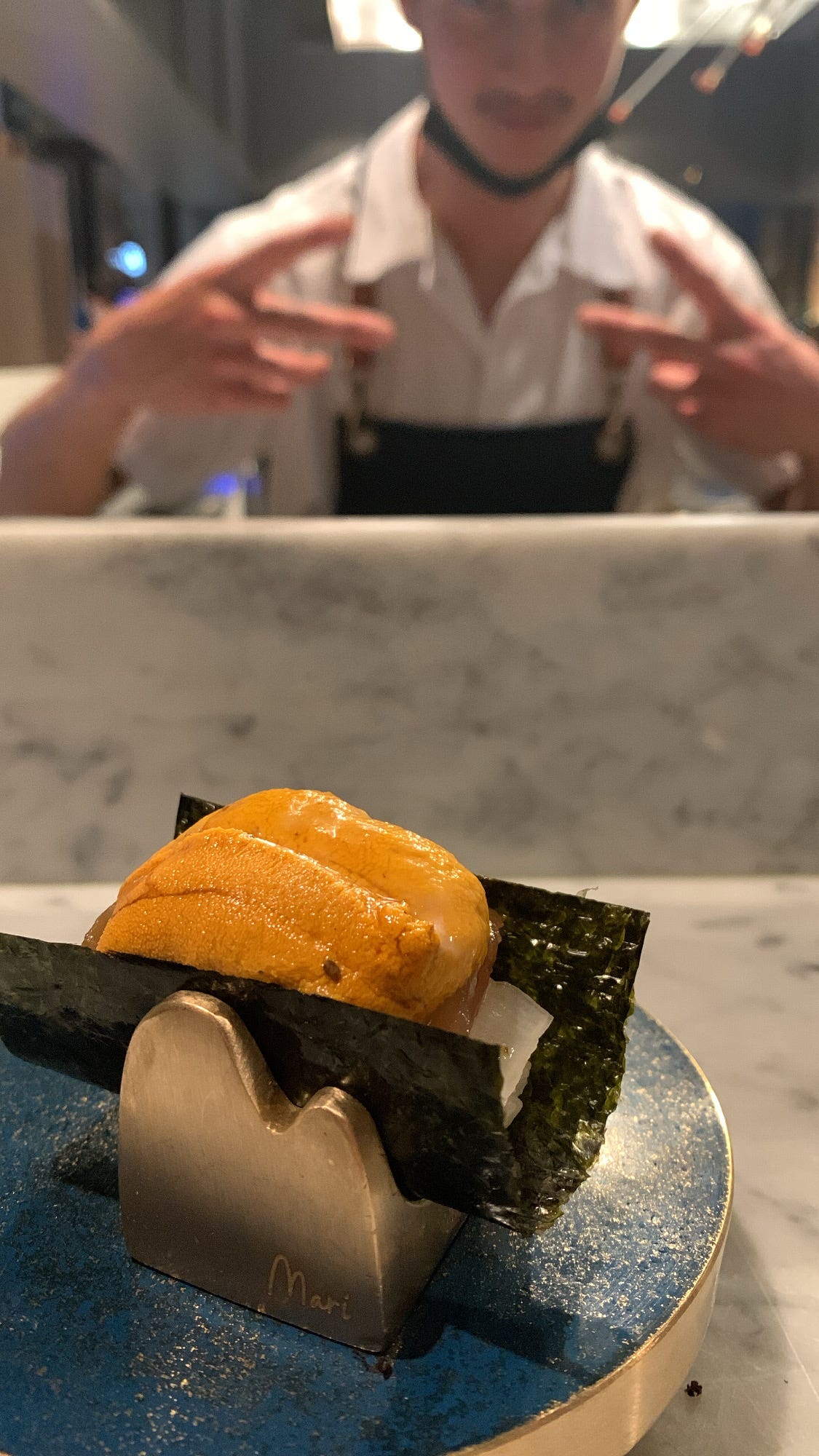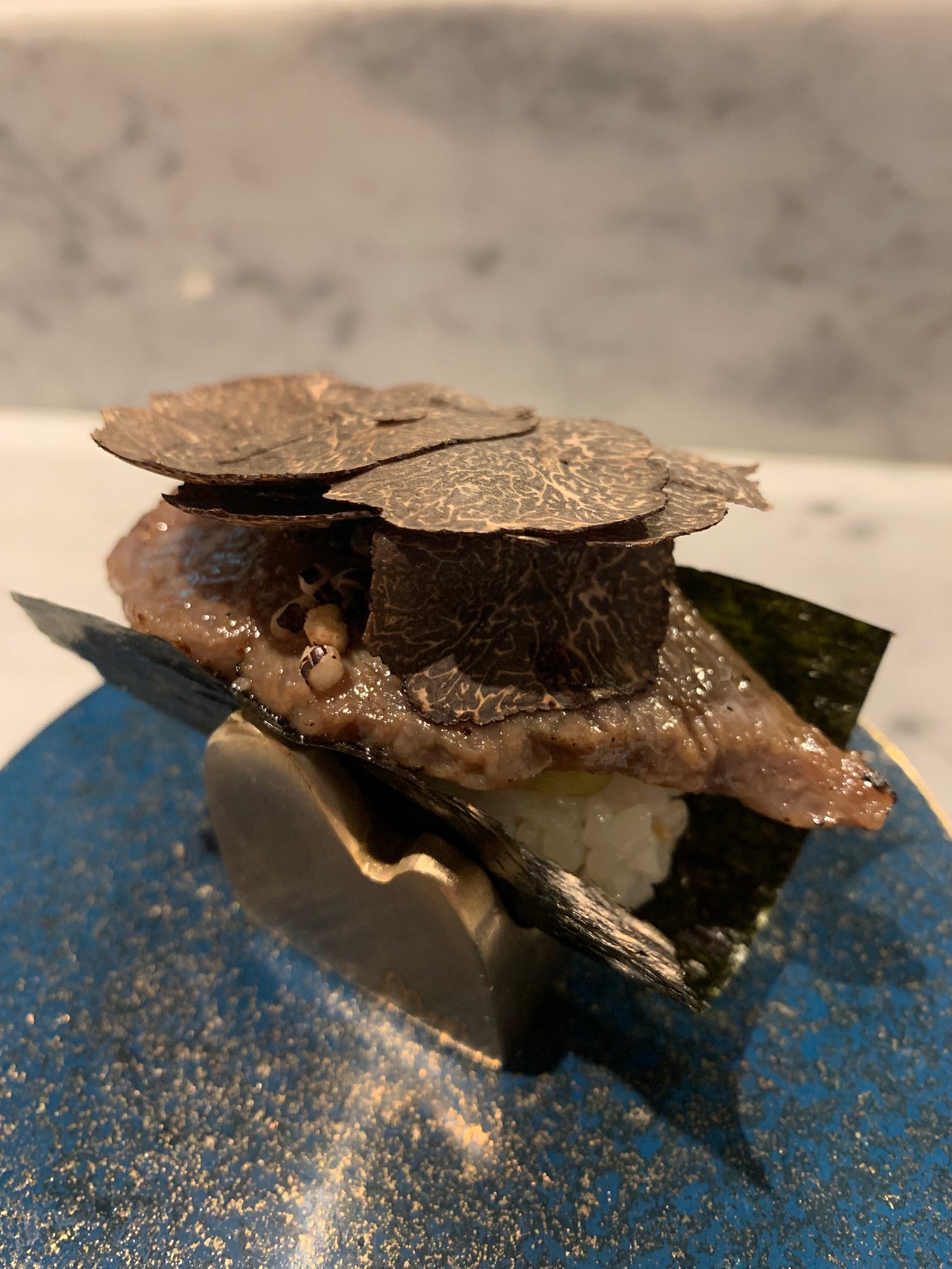Mari 679 9th Avenue Hell's Kitchen Open since: 2021 Price: $$$$ What to order: Tasting menu (the spicy tuna is a highlight!) Jeff's Rating: 8.0/10 A future title contender, but not yet best in its class.
I play Dungeons & Dragons. As you would suspect, I was also extremely cool in middle school. Every couple of months, a group of friends and I gather in a midtown apartment and enter into a Lord of the Rings-esque land filled with magic, intrigue, and all manner of mayhem and monsters.
Dungeons & Dragons has more than a few unique qualities that set it apart from other games. Most obvious is the roleplaying. The key to a good D&D session is to embrace the initial strangeness that comes with embodying a character different from yourself. “Commit to the bit,” as they say, and trust that your friends are going to do the same. Then, once everyone in your group has overcome the initial awkwardness and bad acting, breaking character for comedic effect becomes a fun part of the experience.
Of course, there are also the rules. You can have your character do (or try to do) anything you want in a D&D “campaign” – you just have to roll some dice and see how they land. The dice are your best friends and mortal enemies. Want to climb that wall? Roll for an “athletics check.” Want to figure out what that plant is? That’ll be a “nature check.” You live and die by your rolls (sometimes literally).
It's a Wednesday night at 9:30, and my Dungeons & Dragons crew has a reservation to trade in its 20-sided dice rolls for Korean handrolls at Mari, a new restaurant from Sungchul Shim, the chef that brought the critically acclaimed Kochi to Hell’s Kitchen in 2019. And, like its successful sister restaurant one avenue over, Mari is also gunning for a Michelin star.
I am embarrassed to admit this, but I don’t think I had ever had Korean food prior to coming to New York City. Nonetheless, it has quickly became one of my favorite cuisines after arriving (shoutout to my friend Grace for first showing me tteokbokki). From 24-hour fried chicken restaurants in K-town basements to fine dining establishments like Jua and COTE, I’ve never not had a delicious experience since moving here.
Needless to say, I’m quite excited when I enter Mari, a sleek, white room that’s all sharp edges and polished surfaces. A large rectangular bar fills up most of the space, marble countertops packed with diners chowing down on handrolls and side dishes. In the middle, gleaming metal prep stations illuminated by overhead lamps showcase the kitchen staff at work blowtorching scallops, forming fish by hand, and intermittently chatting up the guests. There’s no art on the sparse walls save for a couple of simple neon signs – the shape of a cloud here, the restaurant’s name there. At Mari, the food is the centerpiece, and I can’t help but notice that the lighting is tailor-made for taking pictures.
My companions are waiting for me at the counter, and as I take my seat a server arrives with water and begins to explain the menu. While the space at Mari is visually striking, the acoustics are atrocious. I can’t hear a word being said, and in this time of waning plague our server’s mask also makes it somewhat more difficult than usual to read lips. My friends and I each nod our heads in faux understanding. No matter – Mari is a tasting menu, and we’re just along for the ride.
Our quest begins. In D&D, players rely on the “Dungeon Master” to guide them through the game, answering any questions and providing new challenges to overcome. While my actual Dungeon Master Paul sits beside me, the man with the blowtorch behind the counter serves in the role tonight, as he begins to produce and explain all manner of increasingly complex dishes for us to try. We never got his name, but let’s call him Jack.
I blink, and a tray of five small appetizers materializes in front of me. “Moving around clockwise,” Jack begins to explain, “we start with the acorn jelly.” I do my best to hear. A fresh oyster, eggplant skewer, wagyu tartare, and a fried rice ball fill out the plate. The jelly is creamy and nutty – I don’t know if I’ve ever tasted acorn before, but now I want some more. The juice of the oyster tastes sweet and lemony, almost like an Italian ice on a summer boardwalk, complimenting the shellfish without need for anything extra. All five bite-size dishes are gone in a flash, and all leave me wanting more (except for the rice ball, which doesn’t have much flavor beyond the fried dough it’s encased in).
Before we know it, out comes a spicy seafood soup. Conversation can barely begin before we hear another explanation from behind the counter. Scallops and shrimp are there, and then they’re gone.
With pleasantries out of the way, Jack introduces us to the heart of the matter, a series of increasingly sophisticated handrolls that I rapidly attempt to jot down notes on as he conjures them up in front of us. The following are my attempts at on-the-spot reactions as transcribed from my phone’s notes app:
Marinated salmon with caviar and sesame seeds – “this is good good” (high praise, I wish I could elaborate)
Marinated shrimp with fried leeks and tartare – “this is good” (I guess I liked it just a bit less than its predecessor)
Cured scallop with vinaigrette and candied anchovies and something else – “the anchovies are sweet and provide a crunch” (I liked this one too!)
It’s here that I begin to contemplate the nature of a tasting menu such as Mari’s. Jack tells us that at Mari, they’re trying to make an experience akin to a Japanese omakase, where the natural flavor of fish is accentuated by subtle notes of wasabi and glazed soy sauce (or sometimes not at all). Yet, at elite establishments such as this one that are all competing with each other, the quality of the ingredients can only take the meal so far. When you’re after that Michelin star, you differentiate your menu via the extra stuff on top, and it seemed to me like that’s what the team at Mari has in mind.
Mushroom three ways with black truffle – “fine. subtle flavors, maybe too subtle” (my friends and I all agreed this was the weakest of the bunch)
Marinated tuna and uni (I have no notes on this one, but the sea urchin was thick and full-bodied. No skimping here)
I take a picture of the uni roll. Jack flashes some peace signs in the background.
Spicy tuna with crispy potato threads and serrano pepper – “prob best spicy tuna I’ve ever had” (this remains accurate as I write this post after the fact)
Grilled mackerel with daikon, black vinegar, and ginger soy jelly – “prob best grilled mackerel with daikon, black vinegar, and ginger soy jelly I’ve ever had” (seems I was in a bit of a joking mood – but this was delicious)
Things are heating up. The back half of this lineup isn’t messing around, and it looks like Jack still has a few heavy hitters up to bat. “Moving on to livestock,” he says as he grins at us from behind the counter. Sure thing Jack, carry on.
Pork belly over gem lettuce with garlic chips and scallions – “stellar” (need I say more?)
A5 wagyu beef with crispy forbidden rice and sliced black truffle – “the truffle was unnecessary” (delicious, but perhaps my commoner’s mouth couldn’t discern the restrained earthiness of the truffle)
And just like that, our handroll journey has ended. Our server brings out bowls of Korean ramen with thick slabs of pork belly floating among the noodles, and Jack begins to explain Mari’s process for hand-toasting the seaweed for their rolls. Paul asks to sample the seaweed, and he and Jack bond over a shared love of cooking and dungeon-mastery.
Jack tells us that, out of all the offerings in the restaurant, the dessert is Mari’s most distinctly Korean dish: choco-pie – a classic snack, here homemade and filled with strawberry jam and sesame marshmallow.
As we finish our meal, Jack gives us a tip on where to go for our next food outing. It seems my Dungeons & Dragons crew has another restaurant on the horizon. On to the next adventure.
In case you were wondering, I play a half-elf bard.









My mouth was watering. Thanks for sharing!